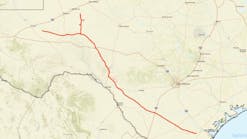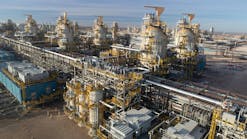Guntis Moritis
Production Editor
Based on the journal's exclusive biennial enhanced oil recovery EOR survey including heavy oil projects, and other estimates, worldwide production from enhanced oil recovery projects at the start of 1994 remained about 1.9 million b/d or about the same as at the beginning of 1992. The 1.9 million b/d represents about 3.2% of the world's oil production.
Although worldwide EOR production has hit a plateau, projects in the next few years in China, Alaska, Indonesia, Canada, Venezuela, and the U.S. Permian basin might boost the production trend upward.
The Journal's current survey found U.S. EOR production decreased by 7/o, to 709,000 bo/d. This production rate is still 10% of the overall U.S. daily oil production, the same as in the last survey (OGJ, Apr. 20, 1992, p. 51). The percentage remained the same because between January 1992 and January 1994, total U.S. oil production dropped almost 400,000 bo/d to 6.9 million b/d. Total U.S. oil production is currently about 6.6 million bo/d.
The number of U.S. EOR projects has steadily decreased since 1986 but this is the first survey showing less production from EOR projects (Fig. 1 and Tables 1 and 2).
Fig. 2 clarifies the type and category of EOR projects covered in this survey.
CANADA
As in the U.S., survey respondents indicate less EOR production in Canada. The 138,000 bo/d (Table B) tabulated is a decrease of 26,000 bo/d from the 1992 survey. Most Canadian EOR production (80%) still comes from hydrocarbon miscible projects.
Canada also is an active area for primary production of heavy oil with steam. The largest project, Imperial Oil Resources Ltd.'s Cold Lake, now produces about 100,000 bo/d (Table J), up by about 20,000 bo/d from 2 years ago.
Completion of Phases 9 and 10 should increase production from this field by another 20,000 bo/d. But because of low oil prices, Imperial has deferred completion of these phases. Esso Resources Canada Ltd. was the previous name of Imperial.
The CO2 projects are also suffering because of the relatively low oil price compared to the price of CO2.
One of the more innovative heavy oil projects is Alberta Oil Sands Technology and Research Authority's (Aostra) test for extracting bitumens with dual horizontal wells drilled from a tunnel. Phase A started in 1987 with three pairs of 197-ft laterals. In Phase B, started in December 1992 longer laterals of 1,640 ft have been producing about 2,000 b/d. Aostra plans to expand the test in 1996 to permit production of 4,000-6,000 b/d. They estimate that a commercial project needs to produce at least 30,000 b/d.
Shell Canada Ltd. also is investigating steam-enhanced, assisted-gravity drainage with horizontal wells in its Peace River field. The test has two horizontal wells, one an injector and the other a producer, drilled from the surface (OGJ, Jul. 11, 1994, p. 99).
Canada now has four heavy oil upgraders to process the heavy oil and bitumens that various estimates place at about 1,700 billion bbl in place.
The most recent, the 46,000 b/d Lloydminster bi-provincial upgrader, came on stream in Novemeber 1992. The upgrader is a joint venture of Husky Oil and the Canadian federal, Alberta, and Saskatchewan governments. Two of the earlier upgraders are located in the Athabasca tar sand deposits and process surface-mined oil sands, not covered in this survey. Recent throughput of two upgraders was about 250,000 b/d.
The Co-op upgrader in Regina, Sask., is Canada's other heavy upgrader. It came on stream in 1988 and has a capacity of 50,000 b/d. The upgrader converts medium and heavy crude oil to a high-quality light crude.
ESTIMATED EOR PRODUCTION
Much has changed in the former republics of the U.S.S.R but we were unable to update their EOR production and are continuing to use the 228,000 b/d of enhanced oil production estimated in 1992.
China National Petroleum Corp. (CNPC) recently indicated that oil recovery using steam has steadily increased to the present 180,000 bo/d (Fig. 3), a 25% increase from 2 years ago. The heavy oil is produced from the Liaohe, Xinjinag, Shengli, and Henan oil fields.
Most of CNPC's EOR production is by cyclic steam injection with some pilot steam drives. The company estimates recoverable oil reserves of about 4.5 billion bbl.
Polymer flooding is being pursued by CNPC in the Daqing, Dagang, Shengli, Liaohe, and Jilin oil fields. It expects oil recovery to increase by 810% of the original oil-in-place. In 1993, the total area under flood was about 3,300 acres and the increased oil production averaged 1,750 b/d.
For a number of other EOR projects in the survey, outside of the U.S, if no update was received and we have indications that the projects are still producing, the last survey information has been retained.
U.S.
Production from carbon dioxide miscible projects has increased by 11% to 161,500 since the previous survey, 2 years ago.
The Permian basin of West Texas has had a number of new projects come on stream and others are in the planning stages (OGJ, Aug 19,1993, p. 19). Two new CO2 pipelines have been laid.
The 119 mile, 12-14 in. Estes pipeline runs east from Denver City, Tex., to Mobil Exploration & Producing Inc.'s Salt Creek field. Denver City is the main supply hub for Permian basin CO2. Shell Pipeline Corp.'s
Cortez pipeline, Amoco Pipeline Co.'s Bravo Dome line, and ARCO Pipeline Co.'s Sheep Mountain line all terminate at Denver City. CO2 capacity of these pipelines is about 1.3 bcfd. CO2 demand is about 1.1 bcfd and it is believed that the pipeline capacity can be expanded to 2 bcfd. CO2 injection in the first phase of the $91 million Salt Creek project began in October 1993.
The Estes pipeline also furnishes CO2 for Oxy USA Inc.'s South Welch and Conoco Inc.'s East and South Huntley projects. CO2 injection in South Welch started in October 1993 and in the Huntleys in January 1994.
The other new CO2 pipeline is Enron Liquid Pipeline Co.'s 4-in., 40 mile pipeline that runs through the southeast comer of New Mexico to move CO2 from a pipeline connection at the Dollarhide Unit, Andrews County, Tex., operated by Union Oil Co., to the El Mar Unit in Loving County, Tex., a CO2 project operated by the independent oil company, Union Royalty Inc. The pipeline was finished and injection started in El Mar in April 1994.
The El Mar project involves an innovative contract between Amoco Production Co. and Union Royalty. Amoco will provide the CO2 in exchange for an interest in the produced oil.
Enhanced oil production from CO2 projects would have been higher if Pennzoil Exploration & Production Co. had estimated the amount of oil attributed to CO2 injection in the Sacroc Unit, the oldest and for a long time the largest CO2 project.
Pennzoil acquired the unit in 1992 from Chevron U.S.A. Production Co. The area of CO2 injection is about 10,000 acres with total oil production of 13,000 b/d. In the last survey, Chevron indicated that almost 12,000 b/d was enhanced oil recovery.
Since acquiring Sacroc, Pennzoil said it has been able to substantially decrease operating costs by shutting down large sections of the waterflood, reorienting injection patterns, and no longer injecting water above the parting pressure of the formation.
Amerada Hess Corp.'s Seminole Unit remains the CO2 project with the largest amount of enhanced production, about 30,200 b/d. The next largest, Shell Western E&P Inc.'s Wasson field Denver Unit, has increased enhanced oil production to 26,000 b/d from 24,200 b/d in the last survey.
In January 1994, Texaco Inc. started the first phase of CO2 injection in its $80 million Slaughter Sundown Unit. The project takes advantage of spare processing capacity at Amoco Production Co.'s Slaughter gas plant.
Production from California steam projects has been hit by the low price, on occasion dropping to about $8/bbl. One hope of California producers is that approval of Prodhoe Bay oil exports to Japan will remove sufficient oil from the California market to raise heavy oil prices. Current price is about $13/bbl.
Shell Oil Co. reported the largest single drop in steam enhanced oil production. Production in its Belridge field decreased to 47,000 b/d from the 65,000 b/d shown in the last survey. Texaco-operated Kern River field remained the most prolific, producing 80,000 b/d. Mobil's Belridge field was the third largest, producing 41,000 b/d, the same as in the previous survey.
Chemical EOR, although never accounting for much U.S. oil production, has continued to decline in use. With current oil prices, the processes are too expensive to implement except in special applications.
Arco Alaska Inc.'s large hydrocarbon-miscible project is continuing to produce 50,000 b/d of enhanced oil and should see an increase once expanded gas processing facilities are completed in the Prudhoe Bay field. The additional capacity will handle another 200 MMcfd and increase the amount of miscible injectant available in the field. The miscible injectant is primarily ethane and propane with some CO2.
With Exxon Corp. changing its flue gas project in the Hawkins field to nitrogen immiscible injection, the survey no longer has any flue gas projects listed.
Microbial EOR has not caught on, although pilot tests have demonstrated that the process is feasible in low temperature, low salinity, shallow reservoirs. Only one respondent indicated having an ongoing project in the U.S.
PLANNED PROJECTS
The planned projects listed (Table A) represent a capital expenditure of about $130 million.
EOR in Alaska will increase once ARCO expands the pilot Kuparuk River field hydrocarbon miscible project to a field-wide project. Funding of the project is still in the approval stage. If approved, staging in of the project is .planned to start in 1997. Natural gas liquids will be obtained from Prudhoe Bay through the Oliktok pipeline. These NGLs blended with Kupuruk produced gas will form the miscible injectant.
The project will use the existing facility infrastructure of the on-going hydrocarbon immiscible flood.
CO2 EOR has the most number of planned projects. Mobil's Postle and Amoco Producing Co.'s Cedar Lake are the largest, but one of the more interesting is Oxy's West Welch project.
This project is jointly funded with the U.S Department of Energy (DOE) as one of DOE's midterm demonstration projects.
West Welch will test the feasibility of cyclic CO2 injection. Namely, the same well will have a CO2 injection cycle followed by a production cycle. Four cycles are planned.
Orla Petco Inc.'s East Ford field project in Reeves County, Tex., will be the second project to obtain CO2 through the new Enron pipeline from Dollarhide.
In one possible project, not included in the list, China's CNPC has an agreement of cooperation with Chevron Corp. to investigate the feasibility of microbial EOR.
The project is now in the laboratory phase.
In a paper presented at the SPE/DOE Ninth Symposium on Improved Recovery last April in Tulsa, E. Delamaide and P. Corley of the Institute Francaise du Petrole and Wang Demin of the Daqing Petroleum Administrative Bureau said that CNPC is preparing to build a 57,000 ton/year polymer (polyacrylamide) plant at the Daqing field to meet expected injection requirements for more than 1 000 wells. Completion of the plant is expected in 1996.
For now, they said, two clusters - each with 26 injectors and 35 producers - are under polymer flood.
Their estimate is that polymer flooding could increase recoverable oil reserves from Daqing by about 1 billion bbl and add 100,000 bo/d to the production rate.
NON-U.S. PROJECTS
Venezuela remains active in steam EOR. Three operating companies produce 242,500 bo/d, up by 8,300 b/d from the previous survey.
Indonesia's Duri field remains the largest EOR project in the world. Enhanced oil production is now up to 245,000 b/d up from 180,000 b/d in the last survey but the field has not reached the previously projected 330,000 b/d.
Copyright 1994 Oil & Gas Journal. All Rights Reserved.

